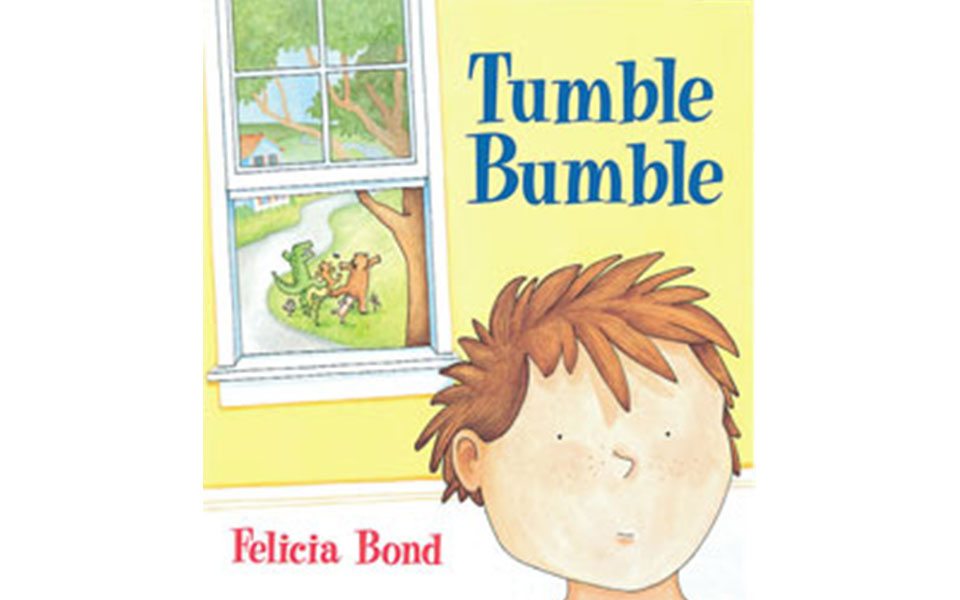Books are a great way to engage your child in learning about language concepts and literacy, all while snuggling and enjoying time together. A win-win experience!
(With examples from Tumble Bumble by Felicia Bond)
https://shop.scholastic.com/shop/en/tso/Tumble-Bumble—Read-Aloud-Book-Pack
- Go to the library. Get a library card, if you don’t have one. Follow this link from The Durham County Library website to find out how you can get yours today: https://durhamcountylibrary.org/services/librarycards/. Let your child pick out some books. Letting your child take the lead here will make this experience all the more engaging and rewarding for them. If you need help finding books, ask the librarian. Librarians love to help. Stay for story time. It will be fun!
- Help your child hold the book. Talk about the cover and the picture on the front. (Oh this book is about a boy and some animals!) Let your child help open the book and turn the pages. Your child is learning pre-literacy skills (how to hold a book and which way to turn the pages). When you get to the end say “the end” so your child learns what that means. When your child is ready, you can teach them more pre-literacy skills like “the author is the person who writes the story and the illustrator draws the pictures.”
- It’s ok to read books over and over. Try to add new books but don’t dismiss favorites. You could try changing things up by calling the main character by your child’s name or insert your child in the story. Some kids love this – others might not want the story changed. Re-reading a book allows your child to feel comfortable and allows you to find different purposes for reading. Perhaps reading the book one night, you might comment and talk about the different colors in the book. Another night you might try counting object within the book. Another night you might talk about the location of objects within the story.
- The words on the page aren’t required! Look at the main characters. Are they animals? Cars? Children? Point to and label the characters on the page. Adding language appropriate to your child’s age and abilities (Oh I see an ant. There it is! It’s a little ant. The cat is much bigger. The crocodile is the biggest!).
- Use voices for each character. Make them silly. If your child begins to lose interest, you can ramp up the fun with facial expressions and gestures.
- Change your voice to reflect emotions and suspense. This will draw attention to these features of the story and help your child develop understanding of pragmatic language and context clues.
- Talk about what the characters are doing and where they are. Expand vocabulary by using a variety of verbs. (The crocodile is smiling/grinning. They walked/strolled. tippy toeing, zigging, zagging)
- Discuss the pictures (describe and ask questions). Ask more open-ended wh- questions rather than yes-no questions (Oh no – the mouse is eating pizza! What is the cat eating? Who is eating ice cream? Where is the pig?) to engage your child. But don’t over-do the questions. Keep book reading fun and engaging rather than like taking a test.
- Look for the rhymes and emphasize them (Glee – bee, jig – pig, road – toad).
- When reading familiar stories, read a line and leave off the final word waiting for your child to fill it in (The startled toad then scared a mouse who bumped into a yellow ____).
- Can your child complete a rhyme? If not, this is a great opportunity to work on rhyming skills to help build their phonemic (sound) awareness.
- Turn reading books into a game by giving clues such as, “I see a tiny animal eating your favorite food.” Or “Where is the animal that says meow?” “I see the toad. It looks like a frog. Sometimes frogs and toads look the same.” This kind of activity helps develop associations.
- Point to an item on the page (ex., ice cream scoop, chocolate sauce) and ask, “What’s that?” or “Who used that?” or “What goes with that?” to develop understanding of functions.
- Before turning the page at a suspenseful point in the story, ask, “What do you think will happen next?” Discuss your child’s guess (prediction) then say (in your best suspenseful voice), “Let’s turn the page and find out” Go back and look for clues in the story that indicated the outcome.
As your child grows, keep reading books together. It’s good for you and it’s good for your child.
Are you unable to make it to a library? While children learn so much simply by having access to and holding a physical book and nothing can replace that, there are other ways to access reading materials electronically. Check out We Give Books, an organization that allows you free access to children’s books online! This is a great organization that also donates books to children and areas of need. https://www.wegivebooks.org/
Blog post by Janet Marron, M.Ed. CCC-SLP

